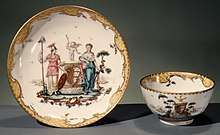Bristol porcelain
Bristol porcelain covers porcelain made in Bristol, England by several companies in the 18th and 19th centuries. The plain term "Bristol porcelain" is most likely to refer to the factory moved from Plymouth in 1770, the second Bristol factory. The product of the earliest factory is usually called Lund's Bristol ware and was made from about 1750 until 1752, when the operation was merged with Worcester porcelain; this was soft-paste porcelain.
In 1770 the Plymouth porcelain factory, which made England's first hard-paste porcelain, moved to Bristol, where it operated until 1782. This called itself the Bristol China Manufactory.
A further factory called the Water Lane Pottery made non-porcelain earthenware very successfully from about 1682 until the 1880s, and briefly made porcelain in about 1845–50.[1]

Bristol was England's second business city after London in the mid-18th century, and a major port for the Atlantic trade. It had long been, after London and together with Liverpool, one of the major centres of production for English pottery, especially tin-glazed English Delftware, some of which aspired to keep up with fashions in decoration such as chinoiserie. This part of the industry continued well into the 19th century, while the various porcelain producers proved short-lived.[3] Bristol was also the largest city in the West Country, which includes the Cornish sites where china stone, an essential ingredient for hard-paste porcelain and bone china, was discovered in the 1740s.
Notes
- "Bristol Potters and Potteries", Research by Reg Jackson
- Metropolitan page: "I.BURKE.OPT.B.M./R.ET I.CHAMPION.D.DD./PIGNVS.AMICTIAE./III/NON.NOV.MDCCLXXIV".
- Hughes, 212-214
- Honey, 4-5, 211 (and note 1)-216
- Honey, 211-212
- Honey, 213-214
- Hughes, 215
- Honey, 215-216
- Hughes, 214-215
- Burton, William (1911). . In Chisholm, Hugh (ed.). Encyclopædia Britannica. 5 (11th ed.). Cambridge University Press. p. 756.
- "The Bristol Factory". Rod Dowling. 22 January 2013. Retrieved 2 October 2015.
- Hughes, 215-216
- Mackenna, F Severne, Champion's Bristol Porcelain, F Lewis, Leigh on Sea, 1947. pp.57–8
- Honey, 336
- Honey, 336; Hughes, 215
References
| Wikimedia Commons has media related to Bristol porcelain. |
- Honey, W.B., Old English Porcelain: A Handbook for Collectors, 1977, 3rd edn. revised by Franklin A. Barrett, Faber and Faber, ISBN 0571049028
- Hughes, G Bernard, The Country Life Pocket Book of China, 1965, Country Life Ltd
Further reading
- Panes, Nicholas, English Potter - American Patriot, 2016. Details here
- Severne-Mackenna, F, Champions Bristol Porcelain, 1947.
- Owen, Hugh, 200 Years of Ceramic Art in Bristol, 1873.

.jpg)